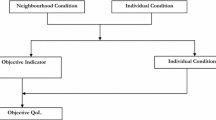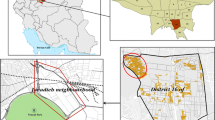Abstract
Quality of life (QoL) is being considered as one of the fundamental concepts in contemporary era. It tries to assess the level of general welfare of the communities. Urban transitional neighborhoods possess specific situation and as a result present distinctive QoL. The major objective of this study is to identify and measure the QoL dimensions in urban transitional neighborhoods using both objective and subjective indices pertaining to Darvazeshemiran neighborhood of Tehran. In order to accomplish this and gather needed data, 244 questionnaires were distributed among Darvazeshemiran’s residents. This study suggests that there exists low level of QoL in the study area. That is 64.3 % of the residents were dissatisfied with the prevailing level of QoL. This in turn is associated with the transitional nature of this neighborhood. The residents were strongly dissatisfied with regard to the environmental qualification as opposed to accessibility status. Furthermore, this study identified five objective factors respectively regarding QoL. There exists low correlation between subjective and objective dimensions. That demands simultaneous consideration of both objective and subjective dimensions. It is argued that individual treatments of each could not accurately represent the QoL of residents.


Similar content being viewed by others
References
Aliakbari, E., & Amini, M. (2010). Quality of urban life in Iran. Social Welfare, 36, 121–148.
Campbell, A., Converse, P., Rodgers, W., & Marans, R. W. (1976). The residential environment. In A. Campbell, P. Converse, & W. Rodgers (Eds.), The quality of American life: Perceptions, evaluations and satisfactions (pp. 217–266). New York: Russell Sage Foundation.
Chen, Z., & Davey, G. (2008). Subjective quality of life in Zhuhai City, South China: A public survey using the international wellbeing index. Social Indicator Research, 91, 243–258.
Cummins, R. A. (1996). The domains of life satisfaction: An attempt to order chaos. Social Indicators Research, 38(1), 303–332.
Cummins, R. (1997). The comprehensive quality of life scale: Intellectual disability (5th ed.). Toorak: Deakin University School of Psychology.
Dahmann, D. C. (1985). Assessments of neighborhood quality in metropolitan America. Urban Affairs Quarterly, 20(4), 511–535.
Das, D. (2008). Urban quality of life: A case study of Guwahati. Social Indicators Research, 88, 297–310.
Dunning, H., Williams, A., Abonyi, S., & Crooks, V. (2008). A mixed method approach to quality of life research: A case study approach. Social Indicator Research, 85, 145–158.
Ebrahimi, S., & Eslami, G. (2010). Iran’s architecture and urban planning in transition periods. Identity of a City, 6(4), 3–14.
Ehlers, E. (2007). Iran: City, village, nomads (trans: Sayidi, A.). Tehran: Monshi.
Epley, D. R., & Menon, M. (2008). A method of assembling cross-sectional indicators into a community quality of life. Social Indicators Research, 88, 281–296.
Felce, D., & Perry, J. (1997). Quality of life: The scope of the term and its breadth of measurement. In R. I. Brown (Ed.), Quality life for people with disabilities: Models, research and practice (pp. 56–76). Cheltnham, UK: Stanley Thornes.
General Bureau of Research, Development of Tehran’s Municipality. (2009). Expansion documents, Darvazeshemiran neighborhood. Tehran: Arin Graphic.
Golledge, R. G., & Stimson, R. J. (1987). Analytical behavioural geography. London: Croom Helm.
Grasso, M., & Canova, L. (2008). An assessment of the quality of life in the European Union based on the social indicators approach. Social Indicator Research, 87, 1–25.
Haas, B. K. (1999). A multidisciplinary concept analysis of quality of life. Western Journal of Nursing Research, 21(6), 728–742.
Hagerty, M. R., Cummins, R. A., Ferriss, A. L., Michalos, A. C., Peterson, M., Sharp, A., et al. (2001). Quality of life indexes for national policy: Review and agenda for research. Social Indicators Research, 55(1), 1–96.
Hazel, H., Lickerman, J., & Flynn, P. (2000). Calvert–Henderson quality of life indicators: A new tool for assessing national trends. Bethesda, Maryland: Calvert Group.
Ibrahim, M., & Chung, W. (2003). Quality of life of residents living near industrial estates in Singapore. Social Indicators Research, 61, 203–225.
Iran Statistics Center. (2011). Year book selected data. www.sci.org.ir/portal/faces/public/sci_en.
Jaberimoghadam, M. (2005). City and modernity. Tehran: The Ministry of Culture and Guidance press.
Johansson, S. (2002). Conceptualizing and measuring quality of life for national policy. Social Indicators Research, 58, 13–32.
Kemp, D., Manicaros, M., Mullins, P., Simpson, R., Stimson, R., & Western, J. (1997). Urban metabolism: A framework for evaluating the viability, livability and sustainability of South East Queensland. Brisbane: The Australian Housing and Urban Research Institute.
Khaksari, A. (2006). Urban districts in Iran. Tehran: Human Science and Cultural Studies Press.
Lee, Y. J. (2008). Subjective quality of life measurement in Taipei. Building and Environment, 43(7), 1205–1215.
Li, G., & Weng, Q. (2007). Measuring the quality of life in city of Indianapolis by integration of remote sensing and census data. International Journal of Remote Sensing, 28(2), 249–267.
Lu, M. (1999). Determinants of residential satisfaction: Ordered logit vs, regression models. Growth and Change, 30, 264–287.
Marans, R. W. (2002). Understanding environmental quality through quality of life studies: The 2001 DAS and its use of subjective and objective indicators. Landscape and Urban Planning, 991, 1–11.
Marans, R. W., & Stimson, R. (2011). Investigating quality of urban life: Theory, methods, and empirical research. Social Indicators Research, 45, 1–29.
McCrea, R., Shyy, T. K., & Stimson, R. (2006). What is the strength of the link between objective and subjective indicator of urban quality of life? Applied Research in Quality of Life, 1, 79–96.
Mitchell, G. (2000). Indicators as tools to guide progress on the sustainable development pathway. In R. J. Lawrence (Ed.), Sustaining human settlement: A challenge for the new millennium (pp. 55–104). London: Urban International Press.
Modarres, A. (2006). Urbanization and the revolution: An introduction to the special issue. Cities, 23(6), 405–406.
Mulligan, G., Carruthers, J., & Cahill, M. (2004). Urban quality of life and public policy: A survey. In R. Capello & P. Nijkamp (Eds.), Advances in urban economics (pp. 729–802). Amsterdam: Elsevier Science B.
Pukeliene, V., & Starkauskiene, V. (2011). Quality of life: Factors determining its measurement complexity. Engineering Economics, 22(2), 147–156.
Rapley, M. (2003). Quality of life research: A critical introduction. London: SAGE.
Rezvani, M. R., & Mansourian, H. (2011). Developing small cities by promoting village to town and its effects on quality of life for the local residents. Social Indicators Research, 110(1), 147–170.
Rezvani, M. R., Mansourian, H., & Sattari, M. H. (2012). Evaluating quality of life in urban areas (case study: Noorabad City, Iran). Social Indicators Research, 112(1), 203–220.
Rojas, M. (2008). Experienced poverty and income poverty in Mexico: A subjective well-being approach. Wodld Development, 3(66), 1078–1093.
Rossouw, S., & Naude, W. (2008). The non-economic quality of life on a sub-national level in South Africa. Social Indicators Research, 86, 433–452.
Santos, L., & Martins, I. (2007). Monitoring urban quality of life: The Porto experience. Social Indicators Research, 80(2), 411–425.
Seik, F. T. (2001). Quality of life in cities. Cities, 18(1), 1–2.
Susniene, D., & Jurkauskas, A. (2009). The concepts of quality of life and happiness correlation and differences. Engineering Economics, 3, 58–66.
Tesfazghi, E. S., Martinez, J. J., & Verplanke, J. J. (2009). Urban quality of life and its spatial distribution in Addis Ababa: Kirkos sub-city. Social Indicators Research, 98, 73–88.
Veenhoven, R. (2000). The four qualities of life: Ordering concepts and measures of the good life. Happiness Studies, 1, 1–39.
Veenhoven, R. (2005). Apparent quality of life in nations: How long and happy people live. Social Indicators Research, 71, 61–68.
Zehner, R. (1977). Indicators of quality of life in new communities. Cambridge: Ballinger.
Author information
Authors and Affiliations
Corresponding author
Rights and permissions
About this article
Cite this article
Soleimani, M., Tavallaei, S., Mansuorian, H. et al. The Assessment of Quality of Life in Transitional Neighborhoods. Soc Indic Res 119, 1589–1602 (2014). https://doi.org/10.1007/s11205-013-0563-9
Accepted:
Published:
Issue Date:
DOI: https://doi.org/10.1007/s11205-013-0563-9




